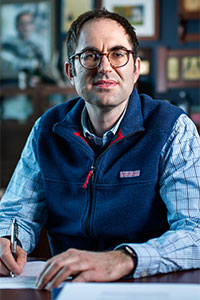
Whether he was replacing crash-damaged panels on a 1974 Buick as a teenager or devising novel instruments to stretch the capabilities of mass spectrometry to enable examination of some of life’s tiniest particles, Mike Westphall brought a body-shop ethic to work.
And those same values of hard work, persistence, and problem-solving influenced Westphall’s university career, which will wrap up on Dec. 22 when he retires as a distinguished scientist III in the lab of Joshua Coon, the Thomas & Margaret Pyle Chair at the Morgridge Institute and UW–Madison professor of biomolecular chemistry.
“It’s fascinating what we, as humans, do with tools and the difference it makes,” Westphall says. “My dad was an auto mechanic, and I had a background futzing with cars. I always liked gadgets, so I always moved on to new types of gadgets.”
For nearly 30 years, Westphall has created, tweaked, and innovated new and complex research instruments to power discovery in biology, chemistry, and astronomy at UW–Madison.
“What interests me is how you measure something that can’t currently be measured,” he says. “I seem to have an attention span of about five years in trying to come up with some weird gadget. A lot of these biologists have been studying the same protein since they were in grad school. I don’t know how they do it.”
“With Mike in the lab there is no instrumentation project that we couldn’t take on. He is also a great role model and mentor to students and other staff.”
Joshua Coon
Coon, who has worked closely with Westphall for more than a decade, said his innovations have been invaluable, opening new avenues for research and grant funding opportunities.
“Mike can build or design anything,” says Coon. “With Mike in the lab there is no instrumentation project that we couldn’t take on. He is also a great role model and mentor to students and other staff.”
Westphall’s latest, and last, five-year project uses instrumentation to unite the potential of mass spectrometry with cryo-electron microscopy. Westphall and his research team modified an Orbitrap mass spec instrument to “aim” single-particle protein complexes onto a chemical matrix directly from the ion beam of the mass spec.
The technology provides the first evidence that the 3D structure of proteins is retained while undergoing mass spec analysis and that atomic structures retain their original shapes outside of the natural environment. The finding has the power to impact the mass spec and EM fields and could give researchers increased confidence in their experimental findings.

The COVID-19 pandemic forced lockdowns in the midst of developing the technology, so Coon and Westphall contacted a local firm and had a milling machine delivered to Westphall’s garage so he could continue his work when campus labs shut down.
“Mike’s abilities to design and build chemical instrumentation meant we could take on problems that one couldn’t dream of without such a talent,” Coon says. “He’s been my right hand for over 10 years. It will be difficult to function without a right hand.”
Westphall admits that his plans for retired life have yet to come into focus. And that’s fine with him.
“Possibly the restoration of vintage vehicles, motorcycles, maybe even musical instruments,” he says. “It will likely be something with a large craft component.”
Westphall’s scientific career began humbly enough.
Westphall’s blue-collar parents weren’t sold on higher education and instead dreamed that one day he would own his own body shop in his hometown of Fort Atkinson.
But Westphall’s love of physics led him to enroll at UW–Whitewater because of its proximity to the body shop. Those paychecks helped finance his undergraduate tuition.
Armed with a magna cum laude bachelor’s degree in physics and math, Westphall took a job at Lawrence University’s Institute of Paper Chemistry developing and working with instruments to gauge the color and reflectivity of paper. The work soon became tiresome.
“All the Ph.D.’s got the fun toys, and I got the less-fun toys,” Westphall says. “It seemed like I was back to doing rust work – the worst job in the body shop.”
The search for excellent toys led him to Washington University, where he earned a doctorate in physics. In 1994, Westphall – whose biology background consisted of a single ninth-grade class – landed his first UW–Madison job, working on the Human Genome Project in the lab of analytical chemistry Professor Lloyd Smith.
There, Westphall worked on methods and instruments to sequence fluorescently labeled DNA base pairs more quickly to advance the international scientific project. Later, he spent two years in the UW–Madison Space Astronomy Laboratory working on sounding rocket payloads to measure the ultraviolet radiation emitted from stars.
“I found out that raising money through the National Institutes of Health was easier than raising money though NASA,” says Westphall, whose next chapter was in the Coon Lab, where in 2019 he won the prestigious Chancellor’s Award for Excellence in Research.
During his career, Westphall was attracted by what can be a maddening chain of advances and setbacks that so often characterize science. “Whether it was mass spec and cryo-EM, DNA sequencing, or this cosmic ray stuff, you’re always looking at some weird little bottleneck that keeps you moving to the next step,” he says. “It’s really kind of a living of failures. If you have success, you’re happy for a day and you go on to the next thing that doesn’t work. It’s not for everybody, but for some reason, I’ve kind of liked it. It suits me.”
